Energy Savings in Industrial Processes: The Influence of Electricity Emission Factor and Financial Parameters on the Evaluation of Long-Term Economics and Carbon Savings
Abstract
1. Introduction
Aim of the Work and Novelty
- scenarios of high inflation rate for energy vectors and sources;
- plausible evolution of carbon dioxide emission factors in electricity conversion.
2. Materials and Methods
2.1. Economic and Financial Parameters
2.2. Emission Factor
- e0 is the emission factor of the first year of operation;
- r is the initial linear growth rate, which is assumed here to be r = 0;
- m is the decay parameter.
- with e0 = initial value of the historical series (e(1990)), least squares approximation on m only, called “model opt(e0 = e(1990))”;
- least squares approximation on both e0 and m, called “model opt”.
2.3. The Case Studies
- A.
- isolation of the intervention with measurement of the main parameters;
- B.
- isolation of the intervention with measurement of all parameters;
- C.
- assessment of the entire plant or structure based on pre- and post-intervention measurements;
- D.
- assessment of the entire plant or structure based on post-intervention measurements combined with a calibrated pre-intervention simulation.
- Case 1. A company operating in the wooden office furniture sector, located in the Province of Padova (North-East Italy). The analysis focuses on the energy savings achieved through a substantial modification of the production processes. In particular, the assembly line was restructured by replacing both the die-cutting machine (Figure 5) and the packaging line (Figure 6), representing an intervention that combined technological upgrading with managerial reorganization. The project was implemented within the framework of the POR FESR 2014–2020 regional funding program (Veneto Region), specifically under the call addressing the “replacement of production cycles with cycles that demonstrably reduce electrical and/or thermal consumption compared to the pre-intervention situation, including per unit of product.” As the company did not have a detailed energy monitoring system in place, IPMVP® Option C was selected for the determination of savings, relying on pre- and post-intervention energy consumption data at the level of the entire plant. The pre-intervention baseline period was defined as the entire year 2019, while the reporting period for the calculation of savings corresponded to the entire year 2021. Two energy audits were carried out according to the ENEA protocol pursuant to Legislative Decree 102/2014 [16], one referring to the baseline year (2019) and the other to the reporting year (2021). The energy data used in the analysis derive from the processing and results of these two audits.
- Case 2. A company that operates in the sheet metal cutting and bending, in the same Province of Padova. The analysis focuses on the reduction in electricity consumption due to the installation of a new laser-cut machine that replaces two different machines for metal cutting and punching, which can be seen in Figure 7. The energy efficiency project is developed under the Italian national framework Industry 5.0 for industrial automation and energy saving. Also this second company is not equipped with energy monitoring, but IPMVP® Option A was selected for the determination of savings, relaying on field measurement of the old machines and the new machine consumption when the same production schedule runs in parallel.
3. Results and Discussion
3.1. Evaluation of Savings—Case 1
- 0.187 × 10−3 toe/kWhe;
- 8.250 × 10−7 toe/Sm3;
- 11,630 kWh/toe.
3.2. Evaluation of Savings—Case 2
3.3. The Impact of Variation in Economic Parameters
- (i)
- to what extent a sustained increase in energy prices amplifies the calculated economic savings; and
- (ii)
- to what extent inflation (Figure 9) affects the actual profitability of energy efficiency investments.
- -
- the type of subject undertaking the investment (e.g., private individual, public administration, company with high or low profit margins);
- -
- the source of capital;
- -
- the company’s financial strategy and profit expectations.
- -
- O (Optimistic): 9% per year;
- -
- ML (Most Likely): 6.7% per year, corresponding to the average electricity price inflation observed between 2005 and 2015;
- -
- P (Pessimistic): 4% per year.
- -
- the case characterized by low inflation and high interest (b = 3%, im = 20%) leads to a marked reduction in the present value of future cash flows;
- -
- the case with moderate inflation and low interest (b = 8%, im = 4%), corresponding to a negative real interest rate, yields a substantially higher NPV;
- -
- the pairs (b = 3%, im = 4%) and (b = 15%, im = 20%), while numerically proportional, produce similar but not identical results due to the nonlinear relationship between nominal interest, inflation, and the derived real interest rate.
3.4. The Impact of the Evolution of the Electricity Emission Factor
4. Conclusions
Author Contributions
Funding
Institutional Review Board Statement
Informed Consent Statement
Data Availability Statement
Acknowledgments
Conflicts of Interest
Nomenclature
| Symbol | Meaning | Unit |
| b | Inflation rate | - |
| E | Electrical energy consumed | kWhe |
| e | Emission factor | kgCO2 kWhe−1 |
| i | Interest rate | - |
| m | Decay parameter | - |
| Q | Quantity of product | - |
| r | Initial linear growth rate | - |
| S | Energy savings | kWhe |
| SC | Specific consumption | kWhe item−1 |
| t | Time | h or y |
| Subscript | Meaning | |
| 0 | Initial value | |
| e | Electricity | |
| m | Monetary | |
| new | New machine | |
| old | Old machine | |
| p | Primary energy | |
| product | Product | |
| r | Real | |
| ref | Reference period | |
| rep | Reporting period | |
| tot | Total | |
| Acronym | Meaning | Unit |
| ENEA | Agenzia nazionale per le nuove tecnologie, l’energia e lo sviluppo economico sostenibile (Italian National Agency for New Technologies, Energy and Sustainable Economic Development) | - |
| EPC | Energy Performance Contract | - |
| EU | European Union | - |
| GDP | Gross Domestic Product | EUR |
| GHG | GreenHouse Gases | - |
| IPMVP | International Performance Measurement and Verification Protocol | - |
| MARR | Minimum Attractive Rate of Return | - |
| ML | Most Likely | - |
| NPV | Net Present Value | EUR |
| O | Optimistic | - |
| P | Pessimistic | - |
| PUN | Prezzo Unico Nazionale (National Single Price) | EUR kWhe−1 |
| WACC | Weighted Average Cost of Capital | - |
References
- European Commission. Directive (EU) 2018/2002 of the European Parliament and of the Council of 11 December 2018 Amending Directive 2012/27/EU on Energy Efficiency; European Commission: Brussels, Belgium, 2018. [Google Scholar]
- European Commission. Directive (EU) 2023/1791 of the European Parliament and of the Council of 13 September 2023 on Energy Efficiency and Amending REGULATION (EU) 2023/955 (Recast); European Commission: Brussels, Belgium, 2023. [Google Scholar]
- European Commission. Commission Recommendation (EU) 2021/1749 of 28 September 2021 on Energy Efficiency First: From Principles to Practice—Guidelines and Examples for Its Implementation in Decision-Making in the Energy Sector and Beyond; European Commission: Brussels, Belgium, 2021. [Google Scholar]
- Liu, L.; Ma, X.Q.; Mao, Z.J. Empirical study on the economic effect of energy conservation and emission reduction in different industrial stages. Adv. Mater. Res. 2014, 962–965, 1541–1546. [Google Scholar] [CrossRef]
- Badami, M.; Camillieri, F.; Portoraro, A.; Vigliani, E. Energetic and economic assessment of cogeneration plants: A comparative design and experimental condition study. Energy 2014, 71, 255–262. [Google Scholar] [CrossRef]
- Bazzocchi, F.; Borgarello, M.; Gobbi, M.E.; Businge, C.N.; Realini, A.; Zagano, C.; Maggiore, S. L’Efficienza Energetica Nell’Industria: Potenzialità di Risparmio Energetico e Impatto Sulle Performance e Sulla Competitività Delle Imprese (In Italian: Energy Efficiency in Industry: Potential for Energy Savings and Its Impact on Business Performance and Competitiveness). RSE Report. 2018. Available online: https://fire-italia.org/wp-content/uploads/2019/07/doc_doc_18001189-318177.pdf (accessed on 4 August 2025).
- Guo, Q.; You, W. Decoupling analysis of economic growth, energy consumption and CO2 emissions in the industrial sector of Guangdong Province. Int. J. Low-Carbon Technol. 2023, 18, 494–506. [Google Scholar] [CrossRef]
- Wu, M. The impact of eco-environmental regulation on green energy efficiency in China—Based on spatial economic analysis. Energy Environ. 2023, 34, 971–988. [Google Scholar] [CrossRef]
- Shen, T.; Sun, L. Evaluating Energy Efficiency Potential in Residential Buildings in China’s Hot Summer and Cold Winter Zones. Int. J. Heat Technol. 2023, 41, 1468–1478. [Google Scholar] [CrossRef]
- Lazzarin, R.M.; Busato, F.; Castellotti, F. Life cycle assessment and life cycle cost of buildings’ insulation materials in Italy. Int. J. Low-Carbon Technol. 2008, 3, 44–58. [Google Scholar] [CrossRef]
- Gao, W.; Zuo, X.; Liu, X.; Yan, L.; Pang, J.; Qiao, W.; Xu, X.; Liang, Y.; Bu, Y. Energy Efficiency Analysis and Energy-Saving Measures for the Steam System in a Cigarette Factory in Zhangjiakou. Int. J. Heat Technol. 2024, 42, 1173–1184. [Google Scholar] [CrossRef]
- Noro, M.; Mancin, S.; Cerboni, F. High efficiency hybrid radiant and heat pump heating plants for industrial buildings: An energy analysis. Int. J. Heat Technol. 2022, 40, 863–870. [Google Scholar] [CrossRef]
- Noro, M. High temperature heat pump with combined cooling, heat and power plant in industrial buildings: An energy analysis. Int. J. Heat Technol. 2023, 41, 489–497. [Google Scholar] [CrossRef]
- Algburi, S.; Mohammed, A.; Abdullah, I.; Hanoon, T.M.; Fakhruldeen, H.F.; Mukhitdinov, O.; Jabbar, F.I.; Hassan, O.; Khudhair, A.; Kato, D. Predictive modeling of building energy consumption and thermal comfort for decarbonization in construction and retrofitting. Results Eng. 2025, 26, 105475. [Google Scholar] [CrossRef]
- Wang, T.; Ma, M.; Zhou, N.; Ma, Z. Toward net zero: Assessing the decarbonization impact of global commercial building electrification. Appl. Energy 2025, 383, 125287. [Google Scholar] [CrossRef]
- Greer, F.; Raftery, P.; Horvath, A. Considerations for estimating operational greenhouse gas emissions in whole building life-cycle assessments. Build. Environ. 2024, 254, 111383. [Google Scholar] [CrossRef]
- Jin, Y.; Xu, S.; Guo, Q.; Xiong, N. Analysis of the Impact of Electricity Emission Factor Selection on High Energy-Consuming Industries under the National Carbon Market Expansion. In Proceedings of the 4th International Conference on Energy Power and Electrical Engineering Epee 2024, Wuhan, China, 20–22 September 2024; IEEE: Piscataway, NJ, USA, 2024; pp. 1050–1053. [Google Scholar] [CrossRef]
- EVO. IPMVP 2016 Basic Concepts. 2016. Available online: https://evo-world.org/en/ipmvp-current/ipmvpcore-concepts/1754-2016-ipmvp-core-concepts-in-italian/file (accessed on 4 August 2025).
- ISO 50015:2014; Energy Management Systems—Measurement and Verification of Energy Performance of Organizations—General Principles and Guidance. ISO: Geneva, Switzerland, 2014.
- Bruni, G.; De Santis, A.; Herce, C.; Leto, L.; Luciani, S.; Martini, C.; Martini, F.; Tocchetti, F.A.; Toro, C.; Salvio, M. L’Obbligo Di Diagnosi Energetica AI Sensi Dell’Art. 8 Comma 1 E 3 Del d.lgs. 102/2014: Le Risultanze Dell’Adempimento Normativo Alla Scadenza Del Dicembre 2020 (In Italian, “The Energy Audit Requirement Pursuant to Article 8, Paragraphs 1 and 3 of Legislative Decree 102/2014: The Results of Regulatory Compliance by the December 2020 Deadline.”); ENEA: Rome, Italy, 2021. [Google Scholar]
- ENEA. ISPRA. 2025. Available online: https://emissioni.sina.isprambiente.it/wp-content/uploads/2025/05/Le-emissioni-di-CO2-nel-settore-elettrico_r413-2025_def.pdf (accessed on 4 August 2025).
- Bertolini, M.; Duttilo, P.; Lisi, F. Accounting carbon emissions from electricity generation: A review and comparison of emission factor-based methods. Appl. Energy 2025, 392, 125992. [Google Scholar] [CrossRef]
- Elio, J.; Milcarek, R.J. Multi-objective electricity cost and indirect CO2 emissions minimization in commercial and industrial buildings utilizing stand-alone battery energy storage systems. J. Clean. Prod. 2023, 417, 137987. [Google Scholar] [CrossRef]
- Sun, X.; Ding, Y.; Bao, M.; Ouyang, X.; Song, Y.; Zheng, C.; Gao, X. Strategic bidding model for multi-energy industrial parks considering spatio-temporal carbon emission factors in carbon and electricity markets. Renew. Sustain. Energy Rev. 2025, 219, 115764. [Google Scholar] [CrossRef]
- Geis, J.; Brown, T.; Hartel, P. Price Formation in a Sector-Coupled Climate-Neutral Energy System. In Proceedings of the International Conference on the European Energy Market EEM, Lisbon, Portugal, 27–29 May 2025. [Google Scholar] [CrossRef]
- Myopic Transition Path. Available online: https://pypsa-eur-sec.readthedocs.io/en/latest/myopic.html (accessed on 27 October 2025).
- Victoria, M.; Zhu, K.; Brown, T.; Andresen, G.B.; Greiner, M. Early decarbonisation of the European energy system pays off. Nat. Commun. 2020, 11, 6223. [Google Scholar] [CrossRef] [PubMed]
- Victoria, M.; Zeyen, E.; Brown, T. Speed of technological transformations required in Europe to achieve different climate goals. Joule 2022, 6, 1066–1086. [Google Scholar] [CrossRef]
- Shen, M.; Hou, Y.; Liang, K.; Zhu, W.; Chong, C.H.; Bin, Y.; Zhou, X.; Ma, L. Energy-system characteristic shifts and their quantitative impacts on China’s CO2 trajectory: Evidence from a high-resolution energy allocation analysis–LMDI sectoral decomposition. Energy 2025, 335, 137905. [Google Scholar] [CrossRef]
- Busato, F. Analisi Economica: Fondamenti e Applicazioni al Sistema Edificio-Impianto (In Italian, “Economic Analysis: Foundations and Applications to the Building-Plant System”); AiCARR Series n. 20; Editoriale Delfino: Milan, Italy, 2014; ISBN 9788897323433. [Google Scholar]

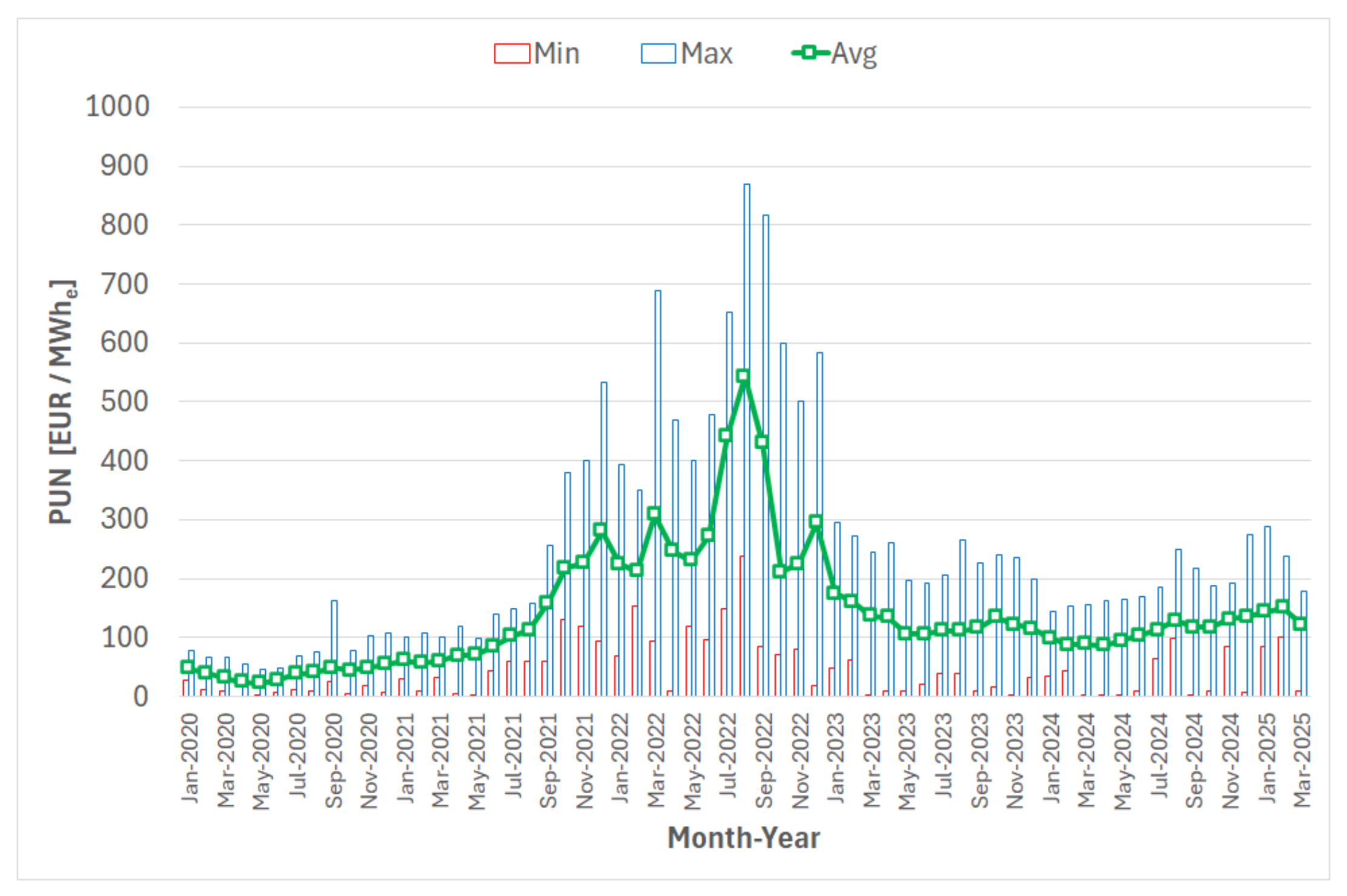

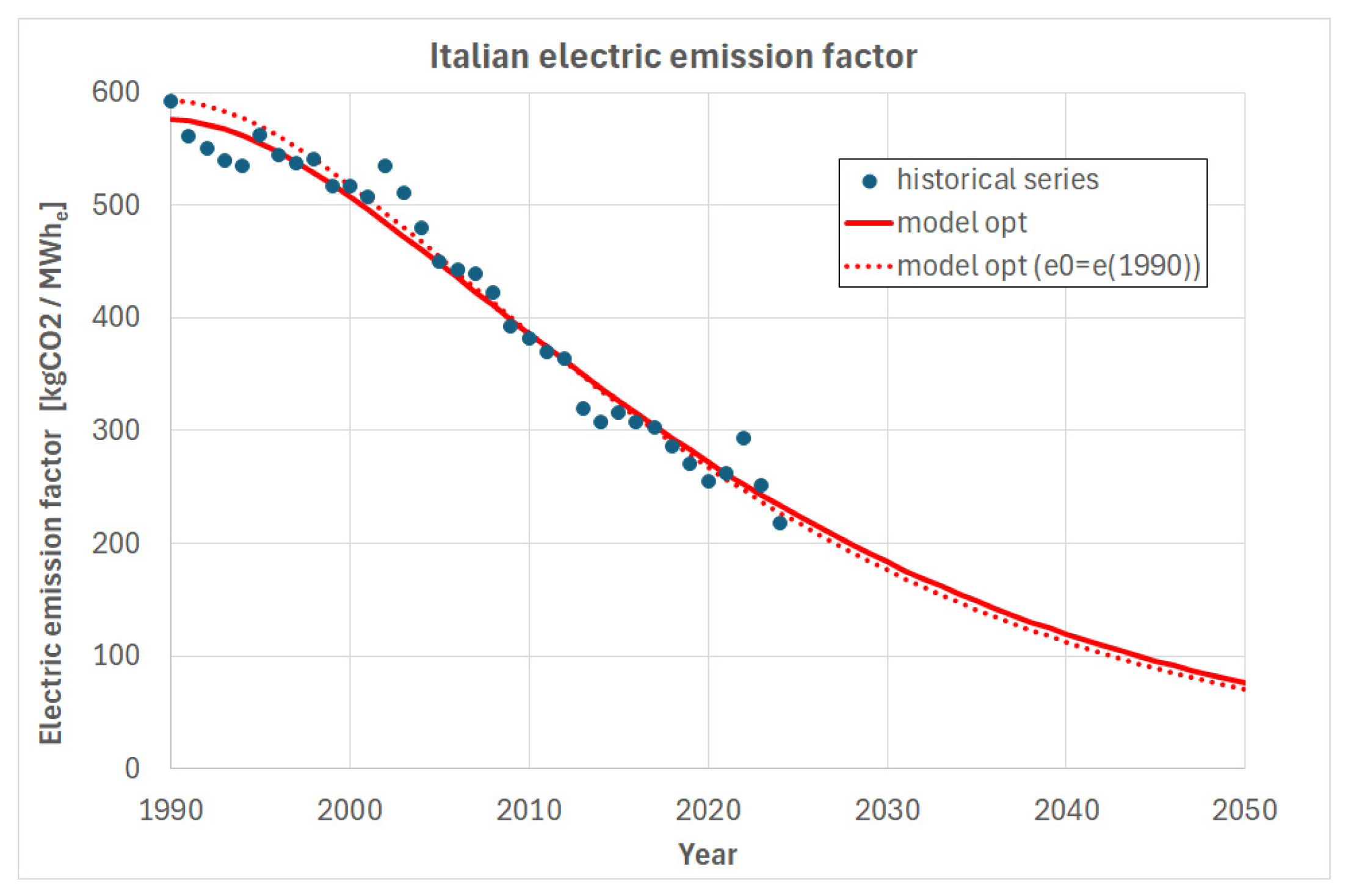
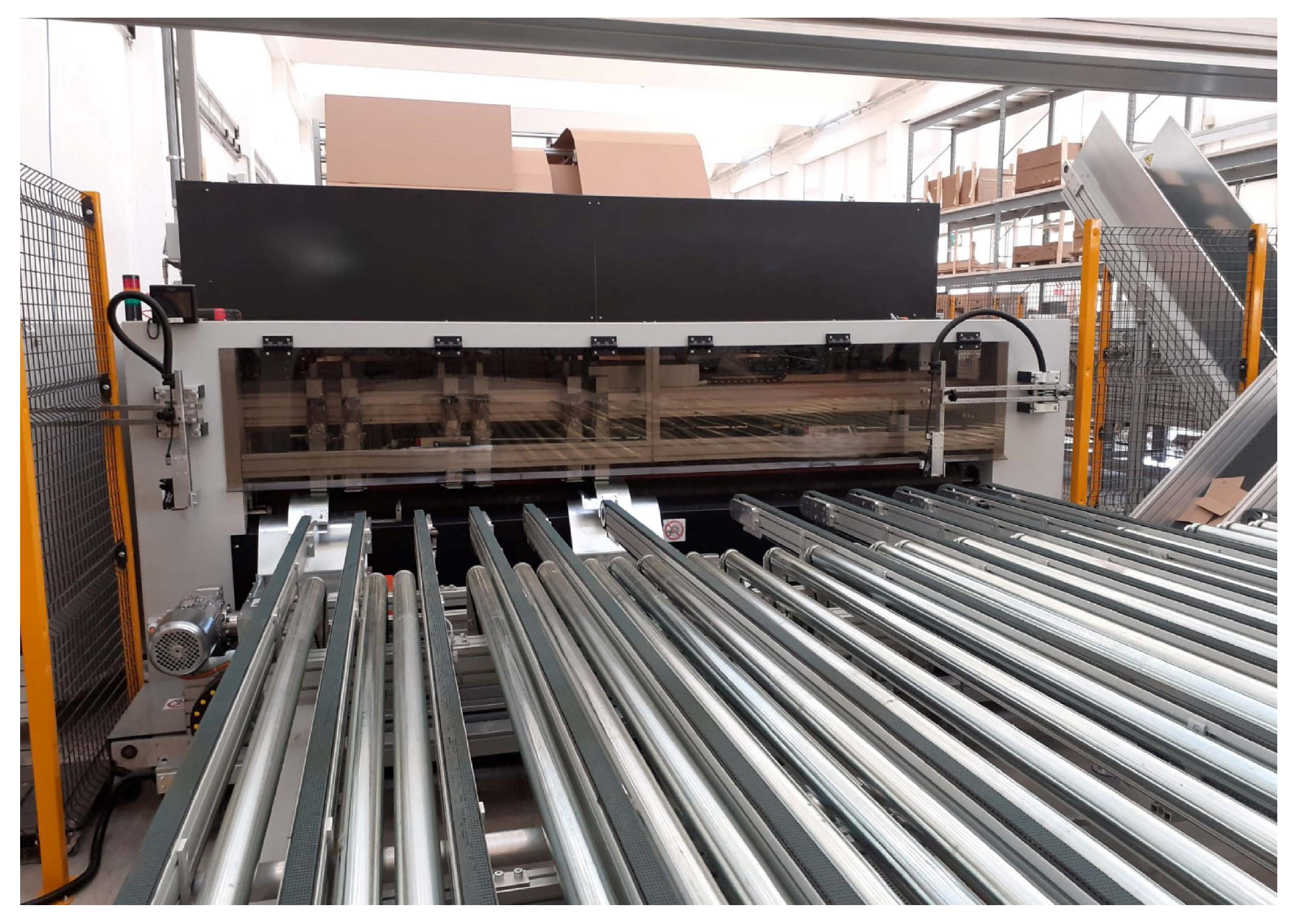

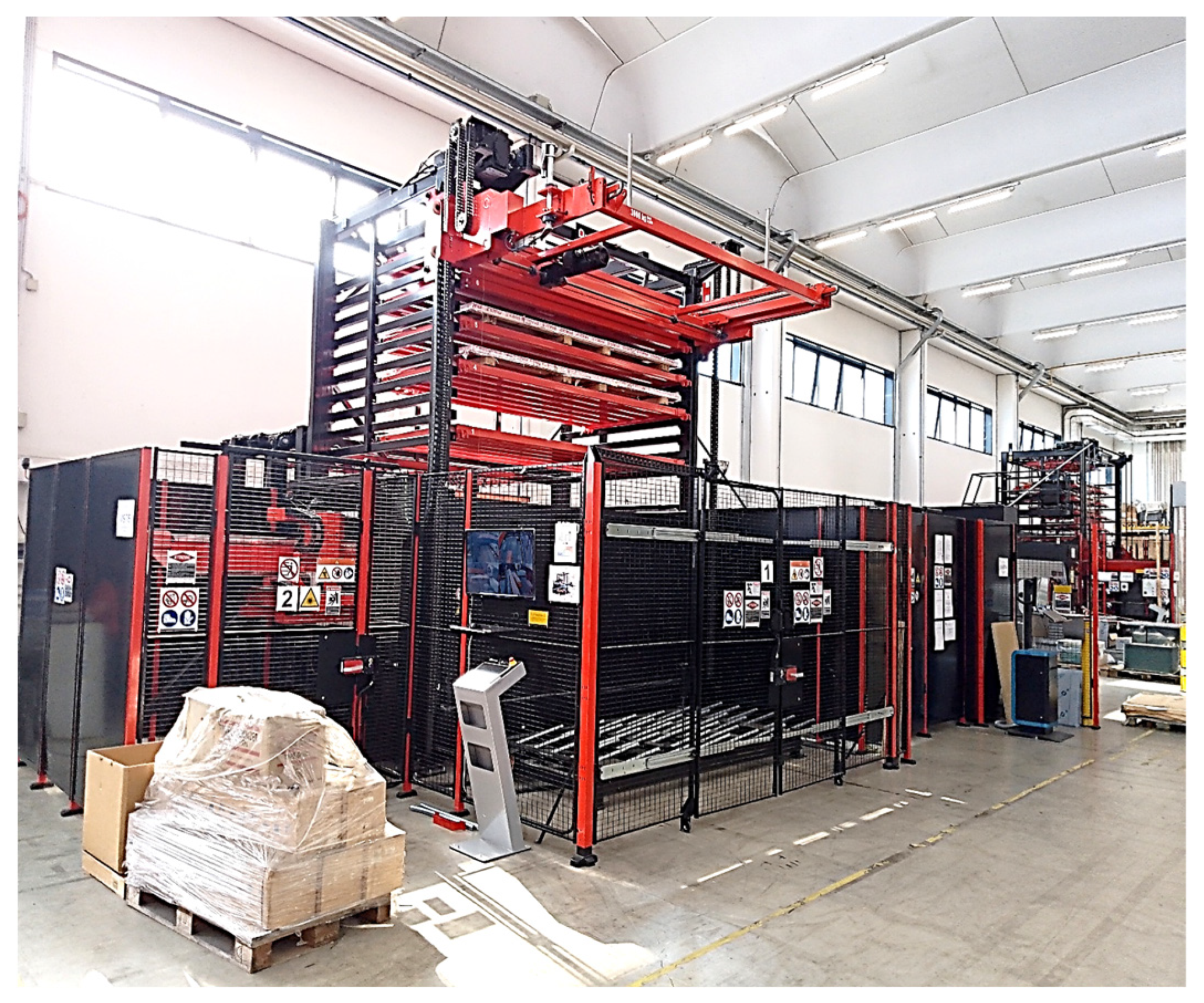
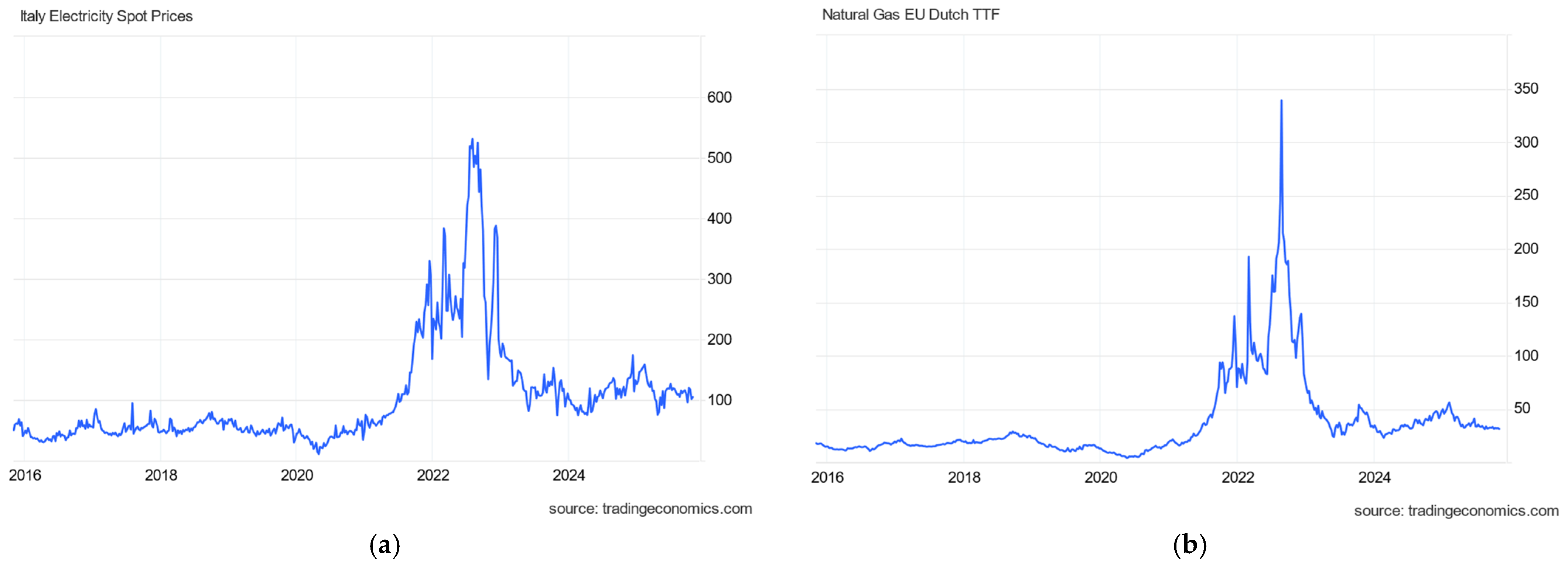

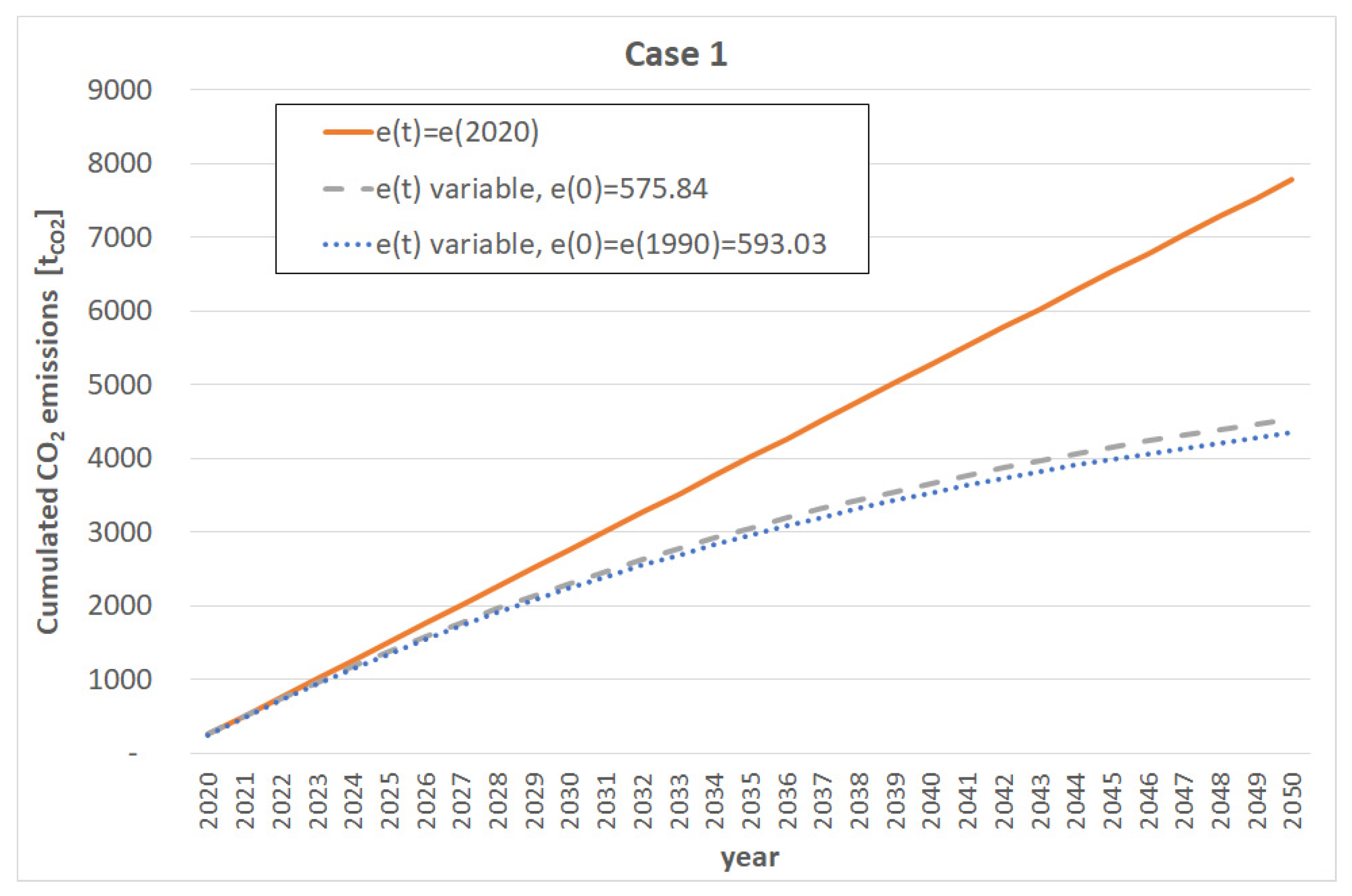
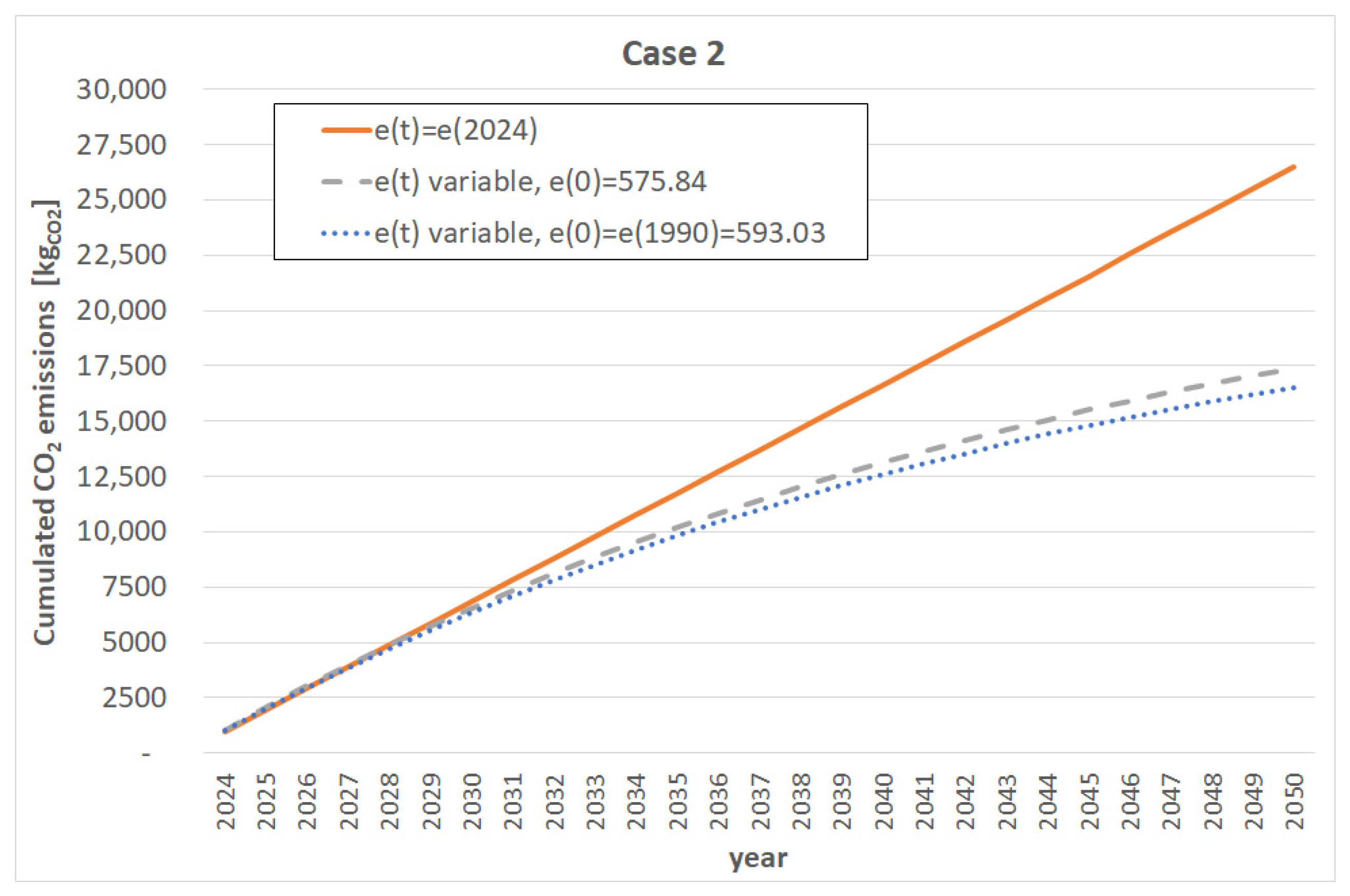
| Fit | e0 (kgCO2/MWhe) | m | R2 |
|---|---|---|---|
| Model opt (e0 = e(1990)) | 593.03 | 0.0613249 | 94.9% |
| Model opt | 575.84 | 0.0588657 | 92.0% |
| Before Intervention | After Intervention, Reporting | After Intervention, Backcasting | Absolute Savings-Backcasting | Relative Savings-Backcasting | |
|---|---|---|---|---|---|
| Year | 2019 | 2021 | 2021 | ||
| Electric energy (kWhe) | 1,629,828 | 1,476,319 | 702,362 | 927,466 | 57% |
| Natural Gas (Sm3) | 117,730 | 128,455 | 61,113 | 56,617 | 48% |
| Quantity of production (kg) | 2,334,090 | 4,906,103 | 2,334,090 | ||
| Non-renewable primary energy (kWhp) | 4,674,804 | 4,514,766 | 2,147,911 | 2,526,893 | 54% |
| Non-renewable primary energy (toe) | 402 | 388 | 185 | 217 | 54% |
| Time Beginning | Time Ending | Items (#) | Electric Consumption (kWhe) | SC (kWhe/Item) | |
|---|---|---|---|---|---|
| Old machines | 9:49 | 18:09 | 337 | 101.54 | 0.30131 |
| New laser cut machine | 10:42 | 20:02 | 337 | 50.97 | 0.15125 |
| b | 3% | 8% | 15% | |
|---|---|---|---|---|
| im | 4% | 2,423,396 | 3,242,639 | 4,899,349 |
| 20% | 1,124,410 | 1,423,410 | 2,001,205 |
| b | 3% | 8% | 15% | |
|---|---|---|---|---|
| im | 4% | 12,402 | 15,436 | 21,217 |
| 20% | 7156 | 8434 | 10,772 |
| Case | Scenario S0 e(t) Fixed | Scenario S1 e(1990) = 575.84 | Scenario S2 e(1990) = 593.03 | Difference S1-S0 (%) | Difference S2-S0 (%) |
|---|---|---|---|---|---|
| Case 1 | 7,785,415 tCO2 | 4,539,093 tCO2 | 4,343,782 tCO2 | −41.7% | −44.2% |
| Case 2 | 26,463 kgCO2 | 17,390 kgCO2 | 16,539 kgCO2 | −34.3% | −37.5% |
Disclaimer/Publisher’s Note: The statements, opinions and data contained in all publications are solely those of the individual author(s) and contributor(s) and not of MDPI and/or the editor(s). MDPI and/or the editor(s) disclaim responsibility for any injury to people or property resulting from any ideas, methods, instructions or products referred to in the content. |
© 2025 by the authors. Licensee MDPI, Basel, Switzerland. This article is an open access article distributed under the terms and conditions of the Creative Commons Attribution (CC BY) license (https://creativecommons.org/licenses/by/4.0/).
Share and Cite
Busato, F.; Noro, M. Energy Savings in Industrial Processes: The Influence of Electricity Emission Factor and Financial Parameters on the Evaluation of Long-Term Economics and Carbon Savings. Appl. Sci. 2025, 15, 11852. https://doi.org/10.3390/app152211852
Busato F, Noro M. Energy Savings in Industrial Processes: The Influence of Electricity Emission Factor and Financial Parameters on the Evaluation of Long-Term Economics and Carbon Savings. Applied Sciences. 2025; 15(22):11852. https://doi.org/10.3390/app152211852
Chicago/Turabian StyleBusato, Filippo, and Marco Noro. 2025. "Energy Savings in Industrial Processes: The Influence of Electricity Emission Factor and Financial Parameters on the Evaluation of Long-Term Economics and Carbon Savings" Applied Sciences 15, no. 22: 11852. https://doi.org/10.3390/app152211852
APA StyleBusato, F., & Noro, M. (2025). Energy Savings in Industrial Processes: The Influence of Electricity Emission Factor and Financial Parameters on the Evaluation of Long-Term Economics and Carbon Savings. Applied Sciences, 15(22), 11852. https://doi.org/10.3390/app152211852







